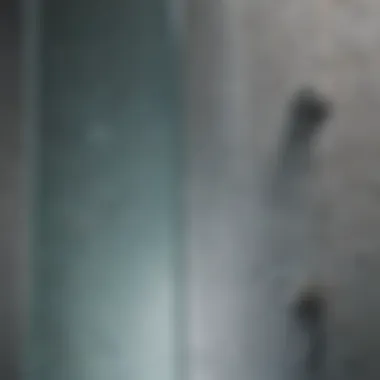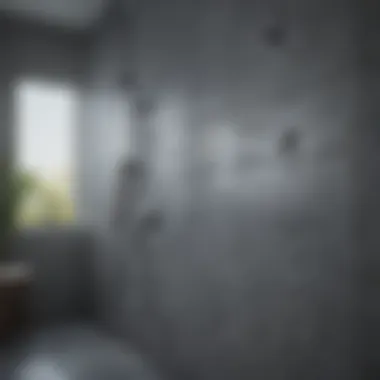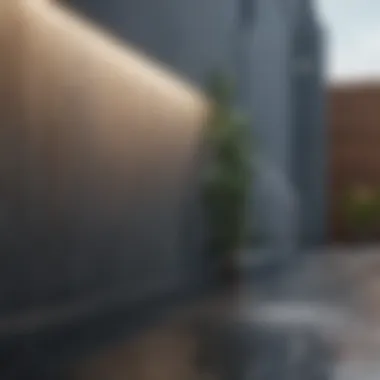Exploring Water Repellent Solutions for Shower Glass


Intro
Water repellent solutions for shower glass are essential in contemporary bathroom design. The persistent accumulation of water stains and soap scum can detract from the visual appeal and hygiene of these spaces. Homeowners often seek effective methods to maintain both cleanliness and aesthetics of shower settings. This article will delve into the importance of these treatments, explore different types available, offer practical application techniques, and discuss the science that underlies their effectiveness.
Understanding how to properly care for shower glass has become increasingly relevant as many prioritize the elegance and upkeep of their living areas. By examining key factors such as the longevity of water repellent coatings, environmental considerations, and user experiences, this comprehensive guide aims to enrich the knowledge of homeowners and design enthusiasts alike.
Design Inspiration
Shower glass is often seen as a centerpiece in modern bathrooms. Its clarity and stylishness can enhance overall design. Effective water repellent solutions not only protect this feature but also elevate its aesthetic.
Current Trends in Interior Design
In today's interior design landscape, minimalism reigns supreme. Clear, unobstructed views through shower glass complement this trend beautifully. However, practicality is crucial. Solutions that repel water can fit seamlessly into simplistically designed bathrooms, allowing for easy maintenance without sacrificing style.
Modern trends lean towards the use of smart materials. Water repellents that are eco-friendly and non-toxic are gaining popularity. Homeowners increasingly prioritize sustainability in their choices, leading to innovative treatments that align with green living practices.
Color Schemes and Palette Ideas
To complement the installation of water-repellent shower glass, selecting appropriate colors is important. Light colors tend to brighten the space. Shades like soft whites, pale blues, or muted greens can make the bathroom feel larger. These colors pair well with the reflective properties of clean glass.
Adding earthy tones creates a soothing atmosphere. Using natural materials such as wood in conjunction with water-repellent glass can foster a sense of harmony. This palette encourages a balance between rustic charm and contemporary flair.
"The right color and treatment combination can turn a functional area into a relaxing retreat."
By refining one’s approach to shower glass, both practicality and design sense can be achieved, resulting in a space that looks good and remains functional for years to come.
Prolusion to Water Repellent for Shower Glass
Water repellent solutions for shower glass hold significant importance in both functionality and aesthetics within modern bathrooms. These solutions are not merely a cosmetic enhancement; rather, they serve critical roles in maintaining hygiene and prolonging the life of the glass. With increasing interest in home improvement projects, understanding how these water repellent coatings work and their associated benefits is essential for homeowners.
The growing trend for open shower designs and expansive glass enclosures means that water repellent treatments have become an integral part of bathroom maintenance. By creating a hydrophobic surface, these coatings effectively minimize water spots and soap scum buildup. This results in clearer and cleaner glass surfaces that do not detract from the overall appeal of the bathroom.
The Necessity of Water Repellent Coatings
Rain or shine, water exposure is a constant phenomenon in the bathroom. The continuous exposure to water leads to a myriad of issues, including stubborn stains and limescale build-up. Applying water repellent coatings to shower glass is thus not just a preference but a necessity. These coatings significantly reduce the amount of time and effort required for cleaning.
"Regular maintenance is essential; however, prevention through coatings greatly lessens the burden of cleaning."
Water repellent coatings work by creating a barrier that physically repels water. This minimizes the mineral deposition from hard water, leading to cleaner glass for significantly longer periods. Furthermore, many coatings also possess anti-bacterial properties, enhancing the overall hygiene of the bathroom environment.
Common Issues Faced by Shower Glass
Many homeowners often encounter common issues with shower glass that can detract from its beauty and functionality:
- Water Spots: These form when water droplets dry, leaving behind mineral deposits that are difficult to remove.
- Limescale Build-Up: Hard water can lead to white, chalky deposits that not only look unattractive but can also etch the glass over time.
- Soap Scum: A combination of soap residues and water hardness that creates a sticky film is often found on shower glass.
Addressing these issues through the application of water repellent coatings can significantly improve the overall longevity and visual clarity of shower glass. The long-term benefits of such solutions far outweigh the initial cost and effort of application.
Types of Water Repellents
When it comes to maintaining shower glass, understanding the different types of water repellents is crucial. Each type offers distinct properties and advantages. Choosing the right solution can effectively enhance the glass's longevity and cleanliness. Key considerations include the application method, effectiveness, and the specific challenges posed by your bathroom environment.
Silicone-Based Water Repellents
Silicone-based repellents are among the most popular options for glass surfaces. These products create a hydrophobic layer that sheds water effectively. They are relatively easy to apply and are known for their durability. However, this type requires proper surface preparation to maximize adhesion and performance. Typically, the lifespan of silicone-based solutions ranges from several months to over a year, depending on usage and maintenance.
Advantages of silicone repellents include:


- Effective Water Shedding: Water beads up and rolls off, reducing streaks and grime.
- Ease of Application: DIY enthusiasts can apply these products with relative simplicity.
- Cost-Effective: They are generally affordable and available in most home improvement stores.
However, they may also have limitations, including:
- Limited Resistance to Chemicals: Certain cleaning agents can degrade the silicone.
- Frequency of Reapplication: They may need to be reapplied more often in high-use environments.
Polymer-Based Coatings
Polymer-based coatings are a more advanced solution, often providing superior protection. These products form a strong bond with the glass, resulting in higher durability and resistance to water and pollutants. Polymer coatings can last significantly longer than silicone options, making them highly attractive for homeowners seeking a long-term solution.
The benefits of polymer-based coatings include:
- Enhanced Longevity: These products can last up to several years with proper care.
- Robust Protection: Resistant to a wider range of contaminants, including soaps and hard water.
- Improved Clarity: Some formulations enhance the clarity of the glass, providing a clearer view.
On the downside, polymer coatings may require a bit more expertise for application, and they can be pricier than their silicone counterparts.
Nano-Coatings: An Overview
Nano-coatings represent the cutting-edge of water repellent technology. Using nanotechnology, these coatings create an ultra-thin layer on the glass surface. Nano-coatings provide exceptional water shedding capabilities and are often invisible to the eye. Their molecular structure allows for better adherence and performance.
Noteworthy features of nano-coatings include:
- Exceptional Water Repellency: Efficient at repelling not just water but also oils and stains.
- Long-Lasting: Many products claim effectiveness for several years.
- Easy Maintenance: They help reduce the frequency of cleaning.
However, these coatings can sometimes be challenging to apply without professional assistance. They also typically come at a higher price point.
Natural Water Repellent Options
For those who prefer eco-friendly alternatives, natural water repellents are available. These options utilize plant-based or mineral-derived ingredients. They often impart less chemical content into the environment, aligning with sustainability principles. While they may not last as long as synthetic options, they can be a viable choice for environmentally conscious consumers.
Advantages of natural water repellents include:
- Eco-Friendly: Typically biodegradable and safe for the environment.
- Non-Toxic: Less impact on indoor air quality compared to chemical options.
- Moderately Effective: Can provide decent water resistance, but generally not as long-lasting as synthetic products.
How Water Repellent Treatments Work
Water repellent treatments are crucial for maintaining the aesthetics and hygiene of shower glass. Over time, water and soap scum accumulate on the glass surfaces, leading to unsightly stains and buildup. By applying a water repellent solution, homeowners can ensure their glass remains clean and clear for longer periods. This section will delve into the science behind how these treatments function, as well as the durability of their effects.
The Science Behind Hydrophobic Surfaces
The primary mechanism at play in water repellent treatments is hydrophobicity. Hydrophobic surfaces repel water, creating a barrier that prevents moisture from adhering to the glass. This is achieved through specific chemical formulations that alter the surface tension properties of the glass.
When water comes into contact with a hydrophobic surface, it forms a bead instead of spreading out. This beading effect is important because it ensures that water tends to roll off the surface rather than cling to it. The science involves micro and nanostructures that enhance these properties. The result is not only easier cleaning but also a reduction in the development of mold or mildew, which often thrive in damp environments.
"Understanding hydrophobic surfaces helps in appreciating the maintenance benefits they offer for shower glass."
Durability and Longevity of Treatments
The effectiveness of a water repellent treatment varies depending on its composition and the conditions of use. Most treating solutions are designed to last for a certain duration. It is essential to consider factors such as the frequency of shower use and the quality of the water.
Generally, silicone-based and nano-coatings tend to provide longer-lasting protection compared to other types. A well-applied treatment can last anywhere from six months to two years. However, regular maintenance and reapplication are recommended to sustain optimal performance. Signs that the treatment is wearing off include increased difficulty in cleaning the glass and visible water marks.
In summary, understanding how water repellent treatments work provides valuable insights into their practical benefits. From reducing cleaning time to preventing stains, their application is an investment worth making for any homeowner.
Application Techniques for Water Repellents
Effectively applying water repellent solutions to shower glass is paramount. This section explains the crucial elements involved in preparing, applying, and maintaining these treatments. Proper techniques not only prolong the life of your treatment but also enhance the visual clarity of your glass. Understanding these processes will help you achieve optimal results and maintain the aesthetics and hygiene of your bathroom.
Preparing the Glass Surface


Preparation is a vital first step. Before applying any water repellent, ensure that the glass surface is clean and free of residues. This phase involves several actions:
- Thorough Cleaning: Use a glass cleaner or a mixture of vinegar and water to clean the surface. This removes soap scum, hard water stains, and any other debris that could interfere with the treatment.
- Drying: After cleaning, dry the glass completely using lint-free cloths. Moisture left on the surface can hinder the adhesion of the repellent.
- Inspection: Check for any scratches or damages. If the surface is compromised, consider repairing before applying the repellent, as imperfections can reduce effectiveness.
"A clean and well-prepared surface is the foundation for a successful water repellent application."
Step-by-Step Application Guide
Once the surface is prepped, the next phase is the application of the water repellent. Following a structured method will ensure even coverage and maximum efficiency. Here is a simple guide:
- Select the Right Product: Choose a suitable water repellent that matches your needs. Silicone-based or nano-coatings have unique properties.
- Read Instructions: Always review the manufacturer’s instructions for specific application techniques and drying times.
- Application: Use a spray bottle or applicator pad. Apply the product evenly across the glass. Work in sections to ensure complete coverage.
- Buffing: After a minute, use a clean, dry cloth to buff the surface. This removes excess product while increasing the shine.
- Curing Time: Allow the treatment to cure as advised in the product’s guidelines. Avoid using water on the treated surface during this period.
Post-Application Care Instructions
Taking good care of the treated glass after application is integral to the longevity of the water repellent. Follow these best practices to maximize performance:
- Avoid Abrasive Cleaners: Use only gentle, non-abrasive detergents for ongoing cleaning. Abrasive cleaners can strip the treatment and damage the glass.
- Regular Maintenance: Clean the surface regularly to prevent buildup. Doing this will help maintain the repellent properties.
- Inspect Periodically: Check the surface for any signs of reduced effectiveness or damage. Detecting issues early can save time and money in the long run.
By adhering to these techniques, homeowners can ensure their shower glass retains its clarity and cleanliness while prolonging the life of water repellent treatments.
Assessing Effectiveness
Assessing the effectiveness of water repellent solutions for shower glass is critical. The benefits of these products extend beyond aesthetics, touching on hygiene and maintenance efforts. Effectiveness can be measured through various performance metrics and user experiences. Homeowners and interior design enthusiasts are especially invested in ensuring their choices deliver sustained results. Understanding the indicators of performance allows for informed decision-making, ensuring investment in the best solutions available.
Performance Metrics to Consider
When measuring the effectiveness of water repellent solutions, several performance metrics should be considered:
- Contact Angle: This metric measures how water beads on the surface. A higher contact angle generally indicates better water repellency.
- Durability: The longevity of the water repellent treatment plays a crucial role. It is essential to know how many months of effective performance can be expected under typical conditions.
- Ease of Cleaning: Effective water repellent coatings should make it easier to clean the glass, reducing the frequency and intensity of scrubbing required.
- Resistance to Mineral Build-up: This refers to the coating’s ability to prevent water spots and staining, which can result from hard water.
These performance metrics are essential when selecting a water repellent product. They help assess if the treatment meets the expectations set during purchasing.
User Experiences and Reviews
User feedback provides valuable insights into the real-world performance of various water repellent solutions. Reviews often highlight key aspects such as:
- Satisfaction with Performance: Customers frequently share their thoughts on how effectively a product performs in real-life conditions, not just in ideal scenarios.
- Comparison to Promised Claims: Users often discuss if they have received the results that were promised by manufacturers, which can be a direct indicator of a product’s credibility.
- Longevity Insights: Many users report how long the treatment lasted before needing reapplication, giving potential customers an idea of long-term value.
"A product may look great on the shelf, but understanding how it performs in the shower is what truly matters."
Homeowners and design enthusiasts often rely on platforms like Reddit or specialized reviews to make educated choices based on collective experiences.
In summary, assessing effectiveness involves understanding different performance metrics alongside customer experiences. This comprehensive approach enables homeowners to choose suitable water repellent solutions, ensuring their shower glass maintenance is both efficient and effective.
Environmental Impact of Water Repellent Products
The use of water repellent treatments on shower glass has grown in popularity due to their effectiveness in maintaining cleanliness and aesthetics. However, it is essential to consider the environmental impact of these products. As homeowners increasingly prioritize sustainability, understanding the ecological footprint of the water repellents they choose becomes critical. This section discusses sustainability considerations and explores eco-friendly alternatives.
Sustainability Considerations
When examining the sustainability of water repellent products, several factors should be taken into account. The production process, materials used, and potential for harm to the environment are all significant. Some common elements to consider include:
- Resource Use: The extraction and processing of raw materials for coatings demand energy and natural resources, which can contribute to resource depletion.
- Chemical Composition: Many commercial repellents contain harmful chemicals that may leach into water systems during application or degradation. This can lead to contamination of aquatic ecosystems.
- Lifecycle Assessment: An examination of the product from manufacturing to disposal can provide insight into its overall environmental burden. Shorter lifespans necessitate more frequent reapplications, resulting in increased waste and resource use.
Innovative companies are focusing on reducing the environmental impact of their products through improved formulations and sustainable practices. Adopting eco-friendly sourcing and production methodologies is crucial for minimizing the carbon footprint associated with these treatments.
Choosing Eco-Friendly Alternatives
For those concerned about the environment, many eco-friendly water repellent options are available. These alternatives provide effective protection while being less harmful to ecosystems. Here are some considerations when selecting products:


- Natural Ingredients: Look for repellents made from plant-based or biodegradable components. These products usually have a lower environmental impact.
- Certifications: Seek water repellents with certifications, such as eco-labels, that verify their environmental claims. These certifications can guide consumers towards more sustainable choices.
- Low-VOC Options: Volatile organic compounds (VOCs) can contribute to air pollution and health issues. Choosing low-VOC water repellents can reduce air quality impacts in homes and surrounding areas.
"The drive toward eco-friendly alternatives not only reflects a trend but a necessary shift for sustainable living. Homeowners can make informed choices that echo their values and priorities."
Using environmentally responsible products enhances the beauty and longevity of shower glass while protecting our planet. As awareness increases, the demand for sustainable water repellent solutions will likely shape future innovations in the industry.
Maintenance and Reapplication
Maintenance and reapplication of water repellent coatings on shower glass is a crucial aspect that often goes overlooked. These coatings, while beneficial, do not last indefinitely. Understanding when to reapply and how to maintain them will prolong their effectiveness. Regular maintenance ensures that the shower glass remains clean, clear, and free from mineral deposits. It also helps in preserving the aesthetic appeal of the bathroom, making it a pleasant space.
Signs That Reapplication is Needed
It is essential to recognize the signs that indicate a need for reapplication of water repellent treatments. Some of the most common signs include:
- Water Spotting: If you notice water spots forming on the glass after the application of water repellent, this could mean the protective layer is wearing off.
- Dull Appearance: A noticeable dullness where once there was clarity indicates that the repellent may no longer be effectively preventing water and soap scum buildup.
- Beading Effect is Lost: The characteristic beading of water on the glass is a sign that the surface is hydrophobic. If the water starts to sheet instead of bead, it's time to reapply.
- Increased Cleaning Efforts: If maintaining cleanliness has become more tedious, it suggests that the water repellent is losing its effectiveness.
Best Practices for Ongoing Care
To maximize the longevity of water repellent solutions, homeowners should adopt best practices for ongoing care. Some practical strategies include:
- Routine Cleaning: Use a soft cloth and pH-neutral cleaner regularly. Avoid harsh chemicals that can degrade the water repellent treatment.
- Regular Inspections: Periodically check the glass for signs of water spots or dullness to catch issues early.
- Follow Manufacturer Instructions: Adhere to the guidelines provided by the product manufacturer for maintenance and reapplication. Different products may have distinct needs.
- Use Soft Water: If possible, use soft water for cleaning and rinsing as it reduces mineral deposits that can cling to glass surfaces.
Efficient maintenance and timely reapplication keep shower glass looking its best and functioning effectively.
By being diligent with maintenance and observant of changing conditions, homeowners can keep their shower glass pristine while enhancing the overall bathroom experience.
Cost Considerations
In the realm of maintaining shower glass, cost considerations play a significant role. Homeowners and design enthusiasts alike need to recognize that investing in water repellent treatments is not just about the purchase price of the product but also involves a broader financial perspective. Understanding these factors can lead to informed decisions that promote both budgetary effectiveness and enhanced bathroom aesthetics.
Budgeting for Water Repellent Treatments
Creating a budget for water repellent solutions demands a thorough assessment of several key aspects. Each treatment option comes with its own price point, influenced by factors like brand reputation, the technology used, and application ease. For instance, nano-coatings are often priced higher due to their advanced technology and longer-lasting effects compared to standard silicone-based solutions.
When budgeting, consider the following:
- Product Type: Silicone-based repellents generally cost less than more advanced options such as polymer or nano-coatings.
- Application Costs: If you opt for professional installation, include those fees in your budget. DIY applications can save money, but require time and effort.
- Longevity and Effectiveness: While it may be tempting to choose the cheapest option, evaluating the treatment's lifespan can affect long-term costs. A more expensive treatment that lasts longer can offer better value over time.
Creating a comprehensive budget helps in aligning expectations and ensuring the chosen product effectively meets both financial and performance needs.
Value Comparison Across Different Products
When exploring water repellent treatments, a thorough comparison of different products is crucial to ascertain their value. Assessing the costs in relation to effectiveness, durability, and ease of application allows for better decision making.
Here are factors to weigh when comparing products:
- Effectiveness: Some products may offer superior water beading and easier cleaning, which can justify a higher price point. Consumer reviews and performance metrics can provide insights into this area.
- Durability: Some treatments last longer, reducing the need for reapplication. Understanding the manufacturer's recommendations on reapplication intervals can lead to better long-term savings.
- User Friendliness: If a product is easy to apply and maintain, it may reduce costs associated with hiring professionals. Balance this against the potential time investment for DIY installation.
Furthermore, reading user feedback on forums such as Reddit or checking dedicated review sites helps paint a clearer picture of what to expect.
"Making a wise decision involves more than just looking at the price tag; consider the long-term benefits and potential savings of higher quality products."
Closure
In this article, we have delved into various aspects of water repellent solutions for shower glass. Understanding these technologies is crucial for homeowners and design enthusiasts alike. The use of water repellents can significantly enhance the appearance and functionality of shower glass, making them essential for any bathroom.
Future Trends in Water Repellent Technologies
As science and technology evolve, so too do water repellent solutions. Future trends indicate a movement towards more eco-friendly and sustainable products. Innovations in nano-coatings are expected to improve durability while minimizing the need for frequent reapplication.
Manufacturers are also exploring bio-based formulations that maintain performance without harming the environment. These advancements should encourage more people to consider these treatments for their homes.
Final Thoughts on Shower Glass Maintenance
Regular maintenance is key to the longevity and effectiveness of water repellent coatings. Understanding how to care for treated surfaces can help homeowners manage their shower glass effectively. Adopting best practices can avoid buildup of minerals and soap scum, preserving both clarity and function.
In summary, water repellent solutions play a vital role in maintaining the aesthetic and hygienic qualities of shower glass. With ongoing advancements and a focus on sustainability, these solutions will continue to evolve and improve.



